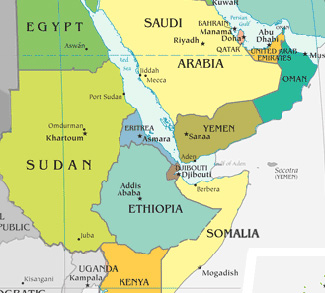What is the issue?
- Resolution of the Ethiopia-Eritrea conflict brings hope for stability and development in the region.
- But there are credible political challenges in both the countries that need to be sorted out to further the peace initiative.
What is the context of the conflict?
- Eritrea was a region in Ethiopia that seceded from it in 1993 after a prolonged violent guerrilla war.
- Both have since been independent countries that lie in close proximity to the Red Sea in the Horn of Africa.

- They were engaged in a conflict for territorial control over the economically insignificant border town of Badme since the late 1990s.
- A peace agreement signed by the two countries in December 2000 and a subsequent border commission awarded Badme to Eritrea.
- But Ethiopia refused to honour the pact and continued to exercise control over Badme by treating it as part of its own territory.
- This resulted in a prolonged standoff between the two countries for almost 2 decades and claimed more than 50,000 lives.
What is the political situation in Ethiopia?
- Positives - The decision to honour the terms of the peace accord is credited to Ethiopia’s current popularly elected Prime Minister “Abiy Ahmed”.
- The Eritrean outreach is one of the many democratic reforms that Mr. Ahmed has unleashed since assuming office a few months ago.
- Significantly, he lifted the emergency, released many political prisoners, and delisted some opposition parties that were classified as terrorists.
- Challenges - Nonetheless, rumblings in the ruling “Ethiopian People’s Revolutionary Democratic Front” is posing problems to the government.
- Traditional tensions between the country’s ethnic Oromo majority and the politically dominant Tigrayan minority are playing out as always.
- Notably, Mr. Ahmed (who is an Oromo) was strategically chosen to ease the churn and ensure a better political balance in the country.
- Unless managed tactfully, these internal tensions within the governing coalition could impede the peace process.
What is the political situation in Eritrea?
- History - Eritrea is ruled by an autocratic president Isaias Afwerki, who rose from through the country’s secessionist guerrilla war with the Ethiopia.
- He has been at the helm since independence by resisting elections and even failed to even honour the 1997 constitution.
- Notably, Ethiopian aggression also provided strong grounds for Eritrean masses to fall in line with the dictates of its dictatorial ruler.
- Oppression - Mr. Isaias used the conflict as a pretext to expand his army and suppress dissent with force, thereby triggering a socio-political crisis.
- This led to mass exodus of people from Eritrea, who has sought refuge in Europe and other countries.
- Future - The end of hostilities could mean a diminishing role for the military and a loosening of President Afwerki’s grip over the state apparatus.
- This could open up a Pandora’s Box in Eritrea and the resulting power struggle needs to be managed well to avoid a violent conflict.
What is the way ahead?
- Restoration of peace and democracy is an urgent priority in both countries, which are among the poorest in the world.
- Peace will allow landlocked Ethiopia to access Eritrean ports, and tie the two countries into greater economic cooperation.
- Greater political accountability at home is a prerequisite for stability across the borders, which demands both sides to display better political wisdom.
- The international community must also step up to engage Ethiopia and Eritrea on fairer terms than it has during the course of the bitter conflict.
- Notably, Ethiopia and Eritrea are strategically located, both as gateways for global trade and for counter-terrorism operations.
Source: The Hindu
